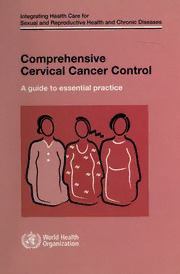
Comprehensive cervical cancer control : a guide to essential practice PDF
Preview Comprehensive cervical cancer control : a guide to essential practice
Integrating Health Care for and Reproductive Health and Chronic Diseases MM , . I - . ..'*. i / I Comprehensive Cervical Cancer Control guide to essential practice | World Health f Organization WHO LibraryCataloguing-in-Publication Data Comprehensivecervicalcancercontrol :aguidetoessential practice 1.Uterinecervical neoplasms-diagnosis.2.Uterinecervical neoplasms- prevention andcontrol.3.Uterinecervical neoplasms-therapy. 4.Guidelines. I.World Health Organization. ISBN924 1547006 (NLM classification:WP480) ISBN978924 154700 © World Health Organization2006 All rightsreserved. PublicationsoftheWorld Health Organizationcan beobtainedfrom WHO Press,World Health Organization,20AvenueAppia, 1211 Geneva27,Switzerland (tel.:+41 22791 3264;fax: +41 22791 4857; e-mail: [email protected]). Requests forpermissiontoreproduceortranslateWHO publications-whetherforsaleorfor noncommercial distribution-should beaddressedtoWHO Press,attheaboveaddress (fax:+41 22791 4806; e-mail:[email protected]). Thedesignationsemployed andthe presentationofthe material inthispublicationdo notimplytheexpressionofanyopinionwhatsoeveronthe partoftheWorld Health Organizationconcerningthe legalstatusofanycountry,territory,cityorareaorofits authorities,orconcerningthedelimitationofitsfrontiersorboundaries. Dotted lineson mapsrepresentapproximateborderlinesforwhichthere maynotyetbefull agree- ment. The mentionofspecificcompaniesorofcertain manufacturers' productsdoes not implythattheyareendorsedorrecommended bytheWorld Health Organization in preferencetoothersofasimilarnaturethatarenotmentioned. Errorsandomissions excepted,the namesofproprietaryproductsaredistinguished byinitial capital letters All reasonable precautionshavebeentaken bytheWorld Health Organizationtoverify theinformation contained inthispublication. However,the published material isbeing distributedwithoutwarrantyofanykind,eitherexpressed orimplied. Theresponsibil- ityforthe interpretationand useofthe material lieswiththe reader. In noeventshall theWorld Health Organization be liablefordamagesarisingfrom itsuse. Printed inSwitzerland. ACKNOWLEDGEMENTS Thispracticeguide hasbeen developed bythe DepartmentofReproductive Healthand Researchandthe DepartmentofChronic Diseasesand Health Promoti ofthe World Health Organization (WHO),withthe InternationalAgencyforResearchon Cancer(IARC),the PanAmerican Health Organization (PAHO),and in collaborationwith theAllianceforCervical CancerPrevention (ACCP),theInternationalAtomic Energy Agency(IAEA),the International FederationofGynecologyand Obstetrics(FIGO),the International Gynecologic CancerSociety(IGCS),andthe EuropeanAssociationfor PalliativeCare (EAPC). Theguide isbasedontheworkofalargegroupofexperts,who participated in consultationsorreviews.WHOgratefullyacknowledgesthecontributionsof: the membersoftheTechnicalAdvisoryGroup(TAG) panel: RoseAnnAugust, Paul Blumenthal,AugustBurns, DjamilaCabral, MikeChirenje, Lynette Denny, Brahim El Gueddari,IrenaKirarFazarinc, Ricardo Fescina, PeterGichangi, SueGoldie, Neville Hacker, MarthaJacob,JoseJeronimo, RajshreeJha, MaryKawonga,Sarbani Ghosh Laskar,GuntaLazdane,JerzyLeowski,VictorLevin, SilvanaLuciani, Pisake Lumbiganon,Cedric Mahe,AnthonyMiller,Hextan Ngan, SherifOmar, Ruyan Pang,JuliettaPatnick, Herve Picard,AmyPollack, Frangoise Porchet,You-Lin Qiao,SylviaRobles, EduardoRosenblatt, Diaa MedhatSaleh, RengaswamySankaranarayanan, RafaellaSchiavon, JacquelineSherris,Hai-Rim Shin, DaivaVaitkiene, EricVan Marck, BhadrasainVikram,ThomasWright, MatthewZarka, EduardoZubizarreta. theexternal reviewers:JeanAhlborg, MarcArbijn,XavierBosch,Elsie Dancel, WacharaEamratsameekool,Susan Garland, NamoryKeito, Ntokozo Ndlovu, Twalib Ngoma,Abraham Peedicayil, RodrigoPrado,JohnSellors,AlbertSinger, EricSuba,JillTabuttHenry. the manyreviewerswhoassisted infield-testingtheguide in China, Egypt, India Lithuania,Trinidad,andZimbabwe. PanAmerican Health Organization WHO ReproductiveHealth <5>#bWtogrkxlwd/OHfafakxltofhthOtrganization andResearch IARC PAHO ACCP tIAEA InternationalAtomicEnergyAgency EAPC k FIGO IGCS WHOcoordinatingteam: PatriciaClaeys, Nathalie Broutet,AndreasUllrich. WHOwritinganddesigningteam: KathyShapiro,EmmaOttolenghi, PatriciaClaeys,JanetPetitpierre. Coregroup: MarthaJacob(ACCP),VictorLevin (IAEA),SilvanaLuciani (PAHO), Cedric Mane(IARC), SoniaPagliusi (WHO),SylviaRobles(PAHO), Eduardo Rosenblatt(IAEA), Rengaswamy Sankaranarayanan (IARC),CeciliaSepulveda(WHO), BhadrasainVikram (IAEA),aswellas the membersofthecoordinatingandwritingteams. WHO isgratefultothe Flemish Government(Belgium)forprovidingthe mainfundingfor thisdocument.Otherdonors,whoarealsogratefullyacknowledged, includetheAlliance forCervical CancerPrevention,the InternationalAtomic EnergyAgency,Groundsfor Health,andtheEuropean Coordination Committeeofthe Radiologicaland Electromedical Industry. 8 CONTENTS Abbreviations and acronyms used in this Guide 1 Preface 3 Introduction 5 - Aboutthe Guide 5 Levels ofthe health care system 9 Essential reading 10 WHO Recommendations 11 Chapter 1: Background 13 Key points 15 Aboutthis chapter 15 Whyfocus on cervical cancer? 16 Who is most affected by cervical cancer? 1 Barriersto control ofcervical cancer 19 The four components of cervical cancercontrol 20 Ateam approach to cervical cancer control 22 Additional resources 23 Chapter2: Anatomy ofthefemale pelvis and natural history ofcervical cancer 25 Key points 27 Aboutthis chapter 27 Anatomy and histology 28 Natural history of cervical cancer 35 Additional resources 42 Chapter3: Health promotion: prevention, health education and counselling 43 Key points 45 Aboutthis chapter 45 Health promotion 45 The role ofthe provider 46 Prevention of HPV infection 46 Health education 48 Counselling 53 Health education and counselling atdifferent levels 55 * Additional resources 56 Practice sheet 1: Health education 59 Practice sheet2: Frequently asked questions (FAQs) about cervical cancer 63 Practice sheet3: Howto involve men in preventing cervical cancer 67 Practice sheet4: Counselling 69 Practice sheet5: Howto use male and female condoms 73 Chapter4: Screening forcervical cancer 79 Key points 81 Aboutthis chapter 81 Role ofthe health care provider 81 Screening programmes 83 Screening tests 92 Follow-up 101 Screening activities at different levels ofthe health system 103 Additional resources 105 Practice sheet6: Obtaining informed consent 107 Practice sheet7: Taking a history and performing a pelvic examination 109 Practice sheet8: Taking a Pap smear 115 \ Practice sheet9: Collecting samplesfor HPV DNAtesting 119 Practice sheet 10: Visual screening methods 123 Chapter5: Diagnosis and managementof precancer 125 Key points 127 Aboutthis chapter 127 Role ofthe provider 127 Management optionsfor precancer 129 Diagnosis 130 Treatment of precancer 133 Follow-up aftertreatment 142 Diagnosis and treatmentactivities at different levels 143 Additional resources 145 Practice sheet 11: Colposcopy, punch biopsy and endocervical curettage 147 Practice sheet 12: Cryotherapy 151 Practice sheet 13: Loop electrosurgical excision procedure (LEEP) 155 Practice sheet 14: Cold knife conization 161 Chapter6: Managementof invasive cancer 165 Key points 167 Aboutthis chapter 167 The role ofthe provider 167 Diagnosis 169 Cervical cancerstaging 170 Principles oftreatment 176 Treatment modalities 179 Patientfollow-up 186 Special situations 187 Talking to patients who have invasive disease and to theirfamilies ... 188 Managementof invasive cancer: activities at different levels 190 Additional resources 191 71 Practice sheet 15: Hysterectomy 193 Practice sheet 16: Pelvicteletherapy 1 Practice sheet 17: Brachytherapy 205 Chapter7: Palliative care 209 Key points 21 Aboutthis chapter 211 The role ofthe health care provider 212 Acomprehensive approach to palliative care 214 Managing common symptoms ofextensive cancer 21 Death and dying 220 Organization of palliative care services 222 Palliative care atdifferent levels ofthe health system 223 Additional resources 224 Practice sheet 18: Pain management 225 Practice sheet 19: Home-based palliative care 231 Practice sheet20: Managing vaginal discharge and fistulae at home 237 Annex 1: Universal precautions for infection prevention 241 Annex 2: The 2001 Bethesda system 245 Annex3: How is a test's performance measured? 247 Annex4: Flowchartsforfollow-up and managementof patients according to screen results 249 4a. Standard approach and example based on pap smearscreening 249 4b.The "screen-and-treat" approach, based on visual inspection with acetic acid as screening test 251 Annex 5: Standard managementofcervical precancer 253
